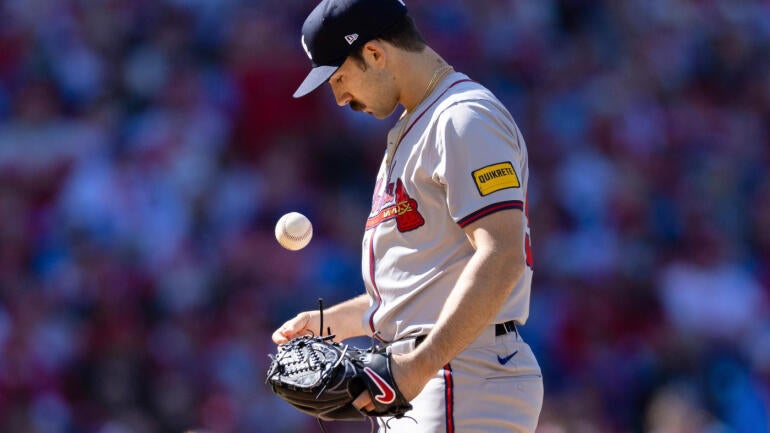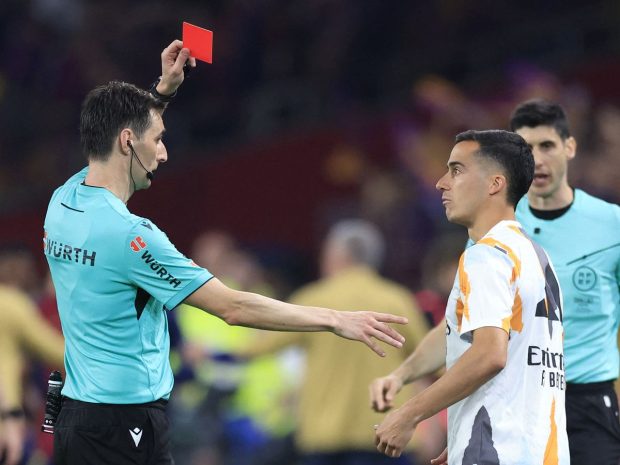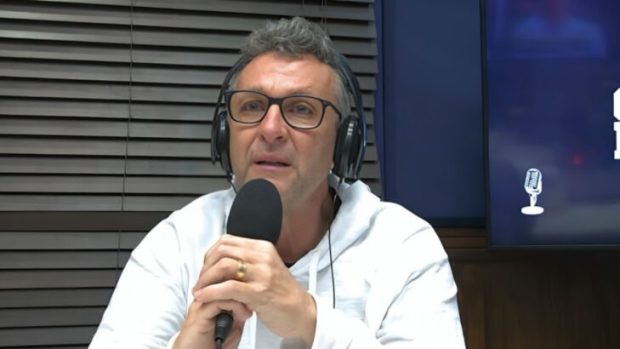

Spencer Strider made his return to the mound for the Braves Wednesday, a little over a year after his 2024 season came to an end due to an elbow injury that required surgery. But did he look like Spencer Strider still?
Yes and no.
Especially early in the start, Strider absolutely looked like himself. He pumped his first pitch of the game right past Bo Bichette at 97 mph for a swinging strike, and he set him down with a wicked slider for a strikeout two pitches later. Vladimir Guerrero fought a bit more, but he ultimately went down flailing at a slider after Strider blew a 97 mph fastball past him earlier in the at-bat.
That was the best he would look all day. That’s not to say Strider looked bad – he allowed just two runs over five innings of work, after all – but there was clearly an adrenaline spike in the first inning that didn’t last, which you can see in his average fastball velocity by inning:
1st: 96.9
2nd: 95.4
3rd: 94.7
4th: 95.3
5th: 94.9
6th: 94.8
In that first inning, he looked like his pre-injury self, averaging 96.9 mph with his four-seamer (he was at 97.2 mph in 2023) and had five swinging strikes on 18 pitches. From that point on, he averaged 95.1 and had eight swinging strikes on 79 pitches. He wasn’t bad after the first inning – 95.1 mph will play with Strider’s movement profile and low arm angle, and a 15% swinging strike rate overall is plenty good – but he wasn’t dominant.
It is worth noting that the Braves clearly left him out there too long. He entered the sixth inning having already thrown 85 pitches when he had only maxed out at 90 in his rehab assignment. It wasn’t like Strider was obviously running out of gas, but his velocity had been flagging for several innings, and with the No. 2 spot in the lineup up to open the inning, it seemed like the Braves were inviting trouble, and Guerrero welcomed it with his first homer of the season; they left Strider in for the next batter too for some reason, and he walked Anthony Santander on five pitches to end his day.
All in all, for his first start back from major elbow surgery, it’s hard to view this as anything but a resounding success for Strider. He wasn’t quite as dominant as he was before the injury, but it’s a pretty good first step. He couldn’t sustain his velocity throughout the outing, something that was also an issue during his rehab assignment, but Strider was still plenty effective sitting nearly 2 mph down from where he was in 2023.
The question moving forward is whether he can be even better than this moving forward. I certainly don’t think this is the best we’re going to see from Strider, but I’m also not convinced we should just assume he’ll be his pre-injury self moving forward, either. This is a second major elbow injury for Strider, and while his stuff was clearly still good, it wasn’t quite at the level it was before the injury. The fact that the Braves were willing to let him approach 100 pitches in his very first start does suggest that Strider won’t be limited much moving forward, which definitely increases the margin for error if there’s little risk of the Braves pulling him when he’s cruising at 80 pitches.
All in all, I think Strider looks like someone you’re going to have in your lineup as long as he remains healthy. And I think he’ll obviously be an impactful arm, with both big per-start upside and plenty of season-long upside – though I do not expect him to be quite as dominant as a strikeout pitcher as he was in 2023. There’s no shame in that – being a top-15 starting pitcher less than 13 months after major arm surgery is pretty impressive!
And he’ll likely continue to add velocity as he goes on. We may see a dip in the next few starts as the first-start adrenaline wears off, and I wouldn’t be surprised to see some bumps in the road along the way, as we’re seeing with Jacob deGrom, who is also dealing with diminished velocity in his own return from a second major elbow surgery. But Strider should be an impact arm as long as he stays healthy, and that was well worth the wait.
Here’s what else you need to know from Wednesday’s action around MLB:
Thursday’s top waiver-wire targets
Drake Baldwin, C, Braves (17%) – The Braves are still finding ways to keep Baldwin’s bat in the lineup despite a disappointing start to his MLB career, and it paid off Wednesday as he hit his first MLB home run while serving as the team’s DH. On Tuesday, the Braves had Baldwin in at catcher, while Sean Murphy served as the DH, and we should expect to continue to see that pairing as long as Ozuna’s hip injury lingers. That might not be past this weekend, but luckily, the catcher position is shallow enough that even Baldwin playing 40% of the games plus a handful of games at DH could still have plenty of value – especially if he ever hits close to his very impressive .375 expected wOBA. Even with Murphy back, there’s plenty of upside here with Baldwin.
Edgar Quero, C, White Sox (5%) – My rule has always been this: If you are a catcher with even moderately interesting skills, I’m going to be interested in adding you for Fantasy in any two-catcher league, because the crop of No. 2 catchers rarely anything more than moderately interesting anyway. I have some leagues where I won’t be looking to add Quero – one where I have Shea Langeliers and Adley Rutschman especially makes it easy to ignore Quero – but in pretty much any league, someone is going to have space for a 22-year-old top prospect who hit .280/.366/.463 in the minors last season. Quero doesn’t have any standout tools as a hitter, but he does a lot of things well enough, especially as a right-handed hitter. I think Baldwin is the more talented hitter, but Quero’s path to immediate playing time is a lot more clear on the White Sox, so I’d say it’s close to a coin flip which you should prioritize. I’ll put Baldwin ahead, but I’m excited to see what Quero can do with some runway.
David Festa, SP, Twins (19%) – The early hook is frustrating, though fairly typical for Twins pitchers. It limits the upside here if Festa is going to be pulled after just 76 pitches, and if that’s enough to keep him off your roster, I get it. But Festa is a legitimately talented pitcher, with a good-enough fastball and genuinely strong slider and changeup. There might be more frustration along the way with the Twins’ usage of him, but in Roto leagues especially, I think you’ll get pretty solid ratios and good strikeout rates from him, at the very least. Especially next week, when he’s slated to take on the White Sox.
Rhys Hoskins, 1B, Brewers (52%) – Hoskins has looked pretty lost through most of the first three weeks of the season, but we’re still at the point of the season where a few good games can totally change how a player looks. Entering play Monday, Hoskins had just a .520 OPS; after back-to-back games with a homer Tuesday and Wednesday, he’s all the way up to a .753 mark. That’s hardly must-start production from a first baseman, but it’s a sign that Hoskins may still have something left in the tank – something we thought might be the case after a big spring. If you missed out on the Tyler Soderstrom/Spencer Torkelson/Ben Rice breakouts at the position, Hoskins still has some upside.
Connor Norby, 3B, Marlins (40%) – It looks like Norby could be back from the IL Thursday, as they are sending erstwhile starter Graham Pauley down to Triple-A. And he’s looking to pick up where he left off last season, when he was a surprisingly useful Fantasy option after a trade to the Marlins, hitting .247/.315/.445 with seven homers and three steals in 36 games. The underlying data doesn’t quite back it up, but Norby does have an .872 OPS in his Triple-A career and could be able to outperform his underlying metrics with a pull-heavy approach. At the very least, I’m excited to see Norby try and make up for lost time after the injury.
This news was originally published on this post .









Be the first to leave a comment